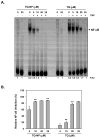Thymoquinone poly (lactide-co-glycolide) nanoparticles exhibit enhanced anti-proliferative, anti-inflammatory, and chemosensitization potential
- PMID: 20105430
- PMCID: PMC2846982
- DOI: 10.1016/j.bcp.2010.01.023
Thymoquinone poly (lactide-co-glycolide) nanoparticles exhibit enhanced anti-proliferative, anti-inflammatory, and chemosensitization potential
Retraction in
-
Retraction notice to “Thymoquinone poly(lactide-co-glycolide) nanoparticles exhibit enhanced anti-proliferative, anti-inflammatory, and chemosensitization potential” [Biochem. Pharmacol. 79 (2010) 1640–1647].Biochem Pharmacol. 2016 Feb 15;102:146. doi: 10.1016/j.bcp.2015.11.011. Epub 2016 Feb 20. Biochem Pharmacol. 2016. PMID: 26985468 Free PMC article. No abstract available.
Abstract
Thymoquinone (TQ), derived from the medicinal spice Nigella sativa (also called black cumin), has been shown to exhibit anti-inflammatory and anti-cancer activities. In this report we employed polymer-based nanoparticle approach to improve upon its effectiveness and bioavailability. TQ was encapsulated with 97.5% efficiency in biodegradable nanoparticulate formulation based on poly (lactide-co-glycolide) (PLGA) and the stabilizer polyethylene glycol (PEG)-5000. Dynamic laser light scattering and transmission electron microscopy confirmed particle diameter between 150 and 200nm. Electrophoretic gel shift mobility assay showed that TQ nanoparticles (NP) were more active than TQ in inhibiting NF-kappaB activation and in suppressing the expression of cyclin D1, matrix metalloproteinase (MMP)-9, vascular endothelial growth factor (VEGF), those are markers of cell proliferation, metastasis and angiogenesis, respectively. TQ-NP were also more potent than TQ in suppressing proliferation of colon cancer, breast cancer, prostate cancer, and multiple myeloma cells. Esterase staining for plasma membrane integrity revealed that TQ-NP were more potent than TQ in sensitizing leukemic cells to TNF- and paclitaxel-induced apoptosis. Overall our results demonstrate that encapsulation of TQ into nanoparticles enhances its anti-proliferative, anti-inflammatory, and chemosensitizing effects.
Published by Elsevier Inc.
Figures






Similar articles
-
Design of curcumin-loaded PLGA nanoparticles formulation with enhanced cellular uptake, and increased bioactivity in vitro and superior bioavailability in vivo.Biochem Pharmacol. 2010 Feb 1;79(3):330-8. doi: 10.1016/j.bcp.2009.09.003. Epub 2009 Sep 6. Biochem Pharmacol. 2010. Retraction in: Biochem Pharmacol. 2016 Feb 15;102:143. doi: 10.1016/j.bcp.2015.11.008. PMID: 19735646 Free PMC article. Retracted.
-
PLGA-encapsulated tea polyphenols enhance the chemotherapeutic efficacy of cisplatin against human cancer cells and mice bearing Ehrlich ascites carcinoma.Int J Nanomedicine. 2015 Oct 30;10:6789-809. doi: 10.2147/IJN.S79489. eCollection 2015. Int J Nanomedicine. 2015. Retraction in: Int J Nanomedicine. 2019 Sep 18;14:7625. doi: 10.2147/IJN.S230533. PMID: 26586942 Free PMC article. Retracted.
-
Formulation, Characterization and Cytotoxicity Effects of Novel Thymoquinone-PLGA-PF68 Nanoparticles.Int J Mol Sci. 2021 Aug 30;22(17):9420. doi: 10.3390/ijms22179420. Int J Mol Sci. 2021. PMID: 34502328 Free PMC article.
-
Concepts and practices used to develop functional PLGA-based nanoparticulate systems.Int J Nanomedicine. 2013;8:747-65. doi: 10.2147/IJN.S40579. Epub 2013 Feb 21. Int J Nanomedicine. 2013. PMID: 23459088 Free PMC article. Review.
-
Therapeutic implications and clinical manifestations of thymoquinone.Phytochemistry. 2022 Aug;200:113213. doi: 10.1016/j.phytochem.2022.113213. Epub 2022 Apr 25. Phytochemistry. 2022. PMID: 35472482 Review.
Cited by
-
Characterization and Antimicrobial Activity of Nigella sativa Extracts Encapsulated in Hydroxyapatite Sodium Silicate Glass Composite.Antibiotics (Basel). 2022 Jan 28;11(2):170. doi: 10.3390/antibiotics11020170. Antibiotics (Basel). 2022. PMID: 35203773 Free PMC article.
-
Aqueous solubility and degradation kinetics of the phytochemical anticancer thymoquinone; probing the effects of solvents, pH and light.Molecules. 2014 May 8;19(5):5925-39. doi: 10.3390/molecules19055925. Molecules. 2014. PMID: 24815311 Free PMC article.
-
Delivery of antiinflammatory nutraceuticals by nanoparticles for the prevention and treatment of cancer.Biochem Pharmacol. 2010 Dec 15;80(12):1833-43. doi: 10.1016/j.bcp.2010.07.021. Epub 2010 Jul 21. Biochem Pharmacol. 2010. PMID: 20654584 Free PMC article. Review.
-
Thymoquinone decreases F-actin polymerization and the proliferation of human multiple myeloma cells by suppressing STAT3 phosphorylation and Bcl2/Bcl-XL expression.Lipids Health Dis. 2011 Dec 16;10:236. doi: 10.1186/1476-511X-10-236. Lipids Health Dis. 2011. PMID: 22177381 Free PMC article.
-
Chemical composition of Nigella sativa Linn: Part 2 Recent advances.Inflammopharmacology. 2016 Jun;24(2-3):67-79. doi: 10.1007/s10787-016-0262-7. Epub 2016 Apr 11. Inflammopharmacology. 2016. PMID: 27068721 Free PMC article. Review.
References
-
- Gleeson MP. Generation of a set of simple, interpretable ADMET rules of thumb. Journal of medicinal chemistry. 2008;51:817–34. - PubMed
-
- Newman DJ. Natural products as leads to potential drugs: an old process or the new hope for drug discovery? Journal of medicinal chemistry. 2008;51:2589–99. - PubMed
-
- Al-Ali A, Alkhawajah AA, Randhawa MA, Shaikh NA. Oral and intraperitoneal LD50 of thymoquinone, an active principle of Nigella sativa, in mice and rats. J Ayub Med Coll Abbottabad. 2008;20:25–7. - PubMed
-
- Morikawa T, Xu F, Kashima Y, Matsuda H, Ninomiya K, Yoshikawa M. Novel dolabellane-type diterpene alkaloids with lipid metabolism promoting activities from the seeds of Nigella sativa. Organic letters. 2004;6:869–72. - PubMed
-
- Badary OA, Taha RA, Gamal el-Din AM, Abdel-Wahab MH. Thymoquinone is a potent superoxide anion scavenger. Drug and chemical toxicology. 2003;26:87–98. - PubMed
Publication types
MeSH terms
Substances
Grants and funding
LinkOut - more resources
Full Text Sources
Other Literature Sources
Research Materials
Miscellaneous

